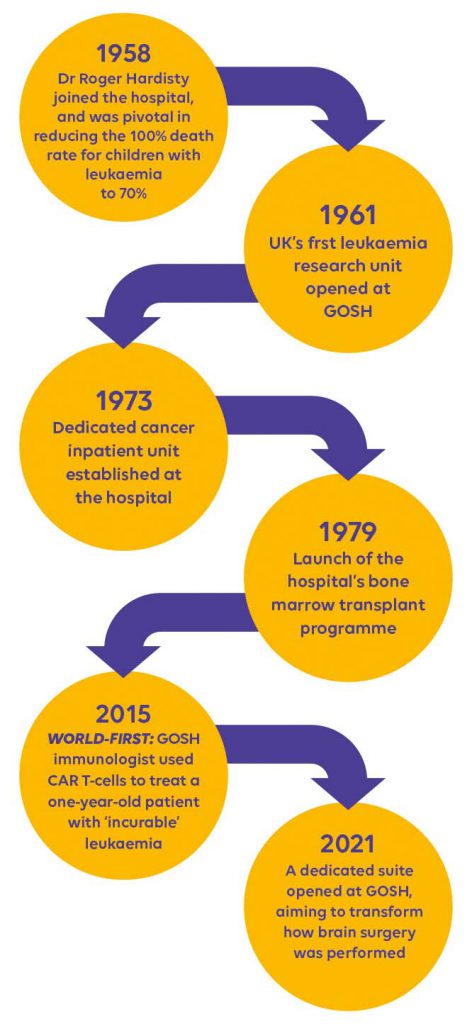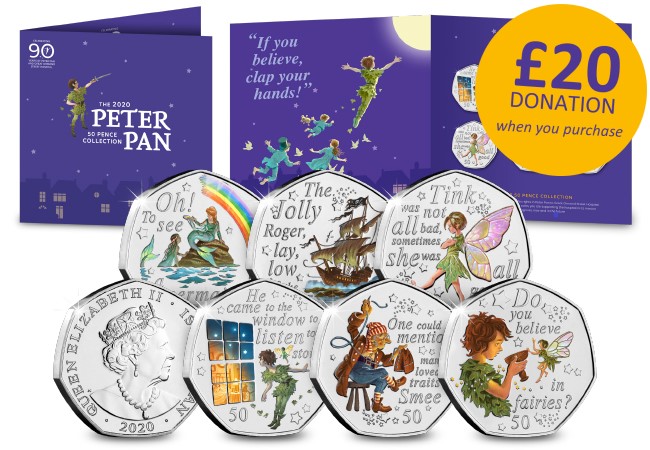Posts Tagged ‘coin collection’
A timeline of Great Ormond Street Hospital’s cancer breakthroughs
Great Ormond Street Hospital (GOSH) is celebrating its 170th anniversary in 2022, marking almost two centuries of transforming the lives of seriously ill children.
And as part of our campaign to raise £30,000 in 30 days for Great Ormond Street Hospital Children’s Charity (GOSH Charity) we’re looking back at some of the hospital’s cancer breakthroughs.
From developing nursing training in the late 19th century and the opening of the UK’s first Leukaemia Research Unit in the 1960s, through to today’s breakthroughs in gene therapy and its pivotal role in the national management of COVID-19, GOSH has been a trailblazer in child healthcare.
Take a look at some pivotal moments throughout the hospital’s history below:

1958
Dr Roger Hardisty joined the hospital, where he became a driving force behind remarkable changes in children’s cancer care. In his three decades at the hospital, he was pivotal in reducing the devastating 100 per cent death rate for children with leukaemia to 70 per cent.
1961
The UK’s first leukaemia research unit opened at Great Ormond Street Hospital.
1970s
Some of the hospital’s early research efforts were starting to show real reward. Chemotherapy was improving. Surgical techniques were becoming safer. Microscopic and genetic research techniques were becoming more sophisticated, allowing researchers to better identify the many different types of cancer, as well as beginning to understand how each would respond to different treatments. A 1971 study showed that long-term survival for children with acute leukaemia had trebled since 1963.
1973
Dedicated cancer inpatient unit established at GOSH.
1977
Hospital consultants set up the first UK-wide Children’s Cancer Study Group to promote research.
1979
Launch of the hospital’s bone marrow transplant programme. GOSH Immunologist Professor Roland Levinsky developed a technique to isolate immune cells in the blood. This made it possible to extract working immune cells from a healthy donor and transplant them into a child – known as a bone marrow transplant. The idea was to replace cancerous blood cells with healthy ones.
1999
Dr Paul Veys developed a kinder bone marrow transplant that is gentler, with less intense chemotherapy and can help children who are too sick for standard doses of drugs.
2013
Launch of one of the first European CAR T-cell studies, pioneered by Professor Persis Amrolia. It paved the way in this rapidly emerging field, but this type of CAR T-cells have now been superceded by ‘next generation’ cells that are more effective.
2015
GOSH immunologist Professor Waseem Qasim used CAR T-cells to treat a one-year-old patient with ‘incurable’ leukaemia. His incredible world-first sparked a new wave of CAR T-cell research around the world.
2018
An 11-year-old boy at GOSH became the first NHS patient to receive CAR T-cell therapy. A landmark agreement between NHS England and the drug manufacturer meant the drug (Kymriah) can now be offered to eligible NHS patients with relapsed ALL.
2019
Results of the CARPALL clinical trial at GOSH suggested that a new CAR T-cell therapy has less side effects and could be more effective at treating ‘incurable’ ALL than similar treatments.
2021
The Khoo Teck Puat iMRI Suite opened at GOSH. The suite promises to transform how brain surgery is performed at GOSH by enabling brain scans to be taken seamlessly during operations.
Imagine how much further GOSH can go in the future with your support. You can help GOSH continue to forge ahead with pioneering breakthroughs, bringing millions of seriously ill children life-altering treatments and cures for generations to come.
Want to help us raise £30,000 in 30 days for Great Ormond Street Hospital Children’s Charity (GOSH Charity)? View our range of special colour edition Peter Pan 50ps here.
Fundraising update for Great Ormond Street Hospital Charity (GOSH Charity) – help us reach £30,000 in 30 days!
So far in our 30 in 30 journey, we have exceeded £5,000 in donations for GOSH Charity!

Thank you very much to those who have already purchased from our Peter Pan 50p range, and everyone at the Westminster Collection hopes you love them as much as we do! The increased donation will be directly sent to GOSH Charity on your behalf.
We have also released a special colour edition of the Peter Pan 50p set, and for every purchase of this brand-new set, we will be donating £20 to GOSH Charity. This could fund an hour of research time with one of our world-leading scientists.
For those who would like to get involved then please view the full range here >>
Find out more about our campaign and where your donations go >>

Our Peter Pan 30 in 30 Campaign for Great Ormond Street Hospital Children’s Charity (GOSH Charity)
Over the past few years, we’re proud to have worked in partnership with GOSH Charity, and with your help raise funds that help support seriously ill children from across the UK who are treated at Great Ormond Street Hospital (GOSH).
However, as you know, the last couple of years haven’t been easy for charities and many fundraising events have been postponed or cancelled due to the pandemic. It’s clear they need our support now more than ever.
That’s why we’re asking for your help once again.
We’re proposing a nationwide initiative to raise £30,000 in 30 days for GOSH Charity.
Today, in partnership with GOSH Charity, we’re announcing a special colour release of the Peter Pan 50p Coins with an increased donation amount.

£20 Donation when you purchase – order yours here
What’s more, these special edition BU Colour 50p coins will only be available over the next 30 days!
When you order any of these special Peter Pan sets within the next 30 days, we’ll send the increased donation directly to GOSH Charity on your behalf. Order yours from the Peter Pan range here!
Fundraising update
So far in our 30 in 30 journey, we have exceeded £5,000 in donations for GOSH Charity! Read more here.


By supporting GOSH Charity at this time, you will help GOSH deliver the practical and emotional support that parents and families need. Your donations could help towards:
- Family accommodation so parents can stay close by while their children undergo treatment.
- Support services including the hospital’s dedicated Play team, which helps patients understand their treatment and cope with separation from peers and siblings.
- The social work service and multi-faith chaplaincy team who provide families and staff with vital advice and support.
View the Peter Pan 50p range here >>


